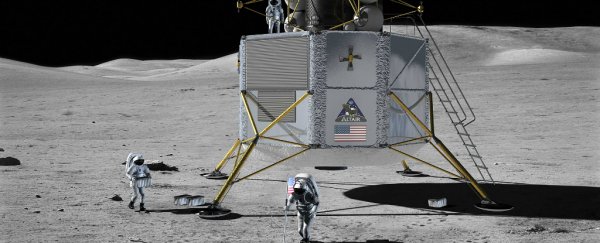It was 47 years ago that NASA won the space race against the Soviet Union, and Apollo 11 astronauts first walked on the Moon.
And now American companies have pitched a series of new plans that would see the country finally return to the lunar surface… this time, alongside the Russians.
The collaboration between the two countries isn't entirely surprising - Russia and America have been working together in space since their association on the International Space Station (ISS) first began in 1993.
But with the ISS scheduled to plummet to its watery grave in 2024, the two countries' space agencies have been preparing to part ways and focus on new projects.
For NASA, that focus is getting humans on Mars by the 2030s, and the US space agency has made it abundantly clear that it has no intention of returning to the Moon anytime soon - unless the Russian space agency Roskosmos or the European Space Agency (ESA) takes the lead.
But while NASA might not be interested in the Moon specifically, a lot of its plans for getting to Mars involve the area around the Moon (known as cislunar space).
For example, step two of the three-step plan involves capturing an asteroid and putting it in orbit around the Moon, so that a crew on board the Orion spacecraft can explore it in the 2020s.
That's why US aeronautical giants such as Boeing and Lockheed Martin foresee demand for the establishment of a lunar base in the near future, and have started pitching the idea to NASA.
And in order to pull it off, the companies have pulled in Russian space contractors such as RKK Energia and GKNPTs Khrunichev to consult on the project - forming a cooperation that could work together to build the first functioning lunar base.
Like NASA, the goal for these companies isn't necessarily the Moon itself, but to build a habitat around the Moon that would serve as a stop along the way to Mars.
There are several pitches floating around at the moment from the cooperative, so it's not entirely clear how the project would work or what it would involve.
But, as Anatoly Zak explains for Popular Mechanics, the general idea is that the Russians would bring the hardware - specifically, the know-how to build space modules that can house crews and contribute to propulsion.
And the Americans will have access to the ridiculously powerful Space Launch System (SLS) that NASA is developing for its mission to Mars - technology that Russia needs if they want to get any kind of space habitat off the ground.
Once the Moon base is in place, the American and Russian companies say that it could be used to study not only the lunar surface, but also the asteroid NASA is planning to drag into the Moon's orbit.
"According to one proposal, astronauts and cosmonauts together could attempt a nearly 400-day mission on the surface of the Moon in the late 2020s to simulate a Martian expedition," writes Zak for Popular Mechanics.
"Don't think of it as a space station around the Moon," added William Gerstenmaier, NASA's Associate Administrator for Human Exploration and Operations, in an interview with the magazine. "Think of it as the beginning of the Mars transit system."
The latest proposals between the American and Russian companies were presented at an ISS research and development conference in San Diego between July 12 and 14, and NASA will now be looking them over.
But Gerstenmaier made it clear that NASA hadn't commissioned the project, so nothing was guaranteed.
"Until we look at them, I can't pass judgment whether they are viable or not," he told Zak. But "it is encouraging that the industry is doing it on its own … and it is consistent with what we are thinking about, including going to cis-lunar space. … So when we, the government, decide something to do, the industry has (already) done its homework."
And with political tension building between Washington and Russia once more, let's hope a collaborative space venture might be just what it takes to get everyone working together for a common goal. After all, science has no borders.
